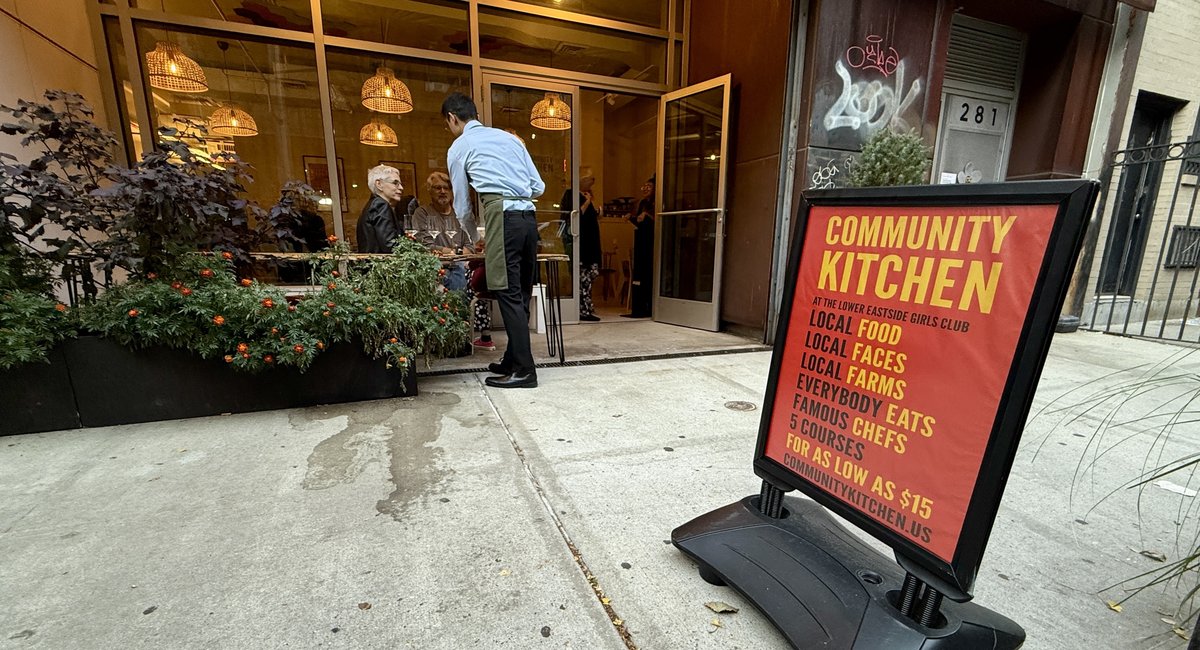As Rebecca Perkins walked home to the Jacob Riis Houses on Avenue D, she paused in front of a glowing storefront on Seventh Street. A staff member noticed and stepped outside with a soft sell.
“It’s a seven-course meal,” the staffer explained. “You can pay $15, $45 or $125 … Whatever you pay, you get the exact same thing.”
Perkins was intrigued.
“That’s pretty good, because living out here in the city is very, very pricey, and food costs are expensive,” she said. “If I could pay $15 for a [seven]-course meal, it’s amazing.”
The storefront is Community Kitchen, a nonprofit “sliding-scale” restaurant that aims to make high-quality, ethically sourced meals accessible to all New Yorkers, regardless of income. It offers an unusual combination in the city’s food scene: a fine-dining experience with no distinction in service or menu based on what diners pay.
Community Kitchen opened Sept. 19 inside the Lower Eastside Girls Club, serving dinner Wednesday through Saturday, through Thanksgiving. It’s the brainchild of longtime food writer Mark Bittman, known for his New York Times columns and books like “How to Cook Everything,” and Rae Gomes, a food justice advocate and cofounder of the Central Brooklyn Food Co-op.
Together, they hope to prove that good food can be both elegant and equitable, and that a sliding-scale model can work in a city where affordability and access are often in conflict.
“We wanted to pilot this as proof of concept for ourselves, and for funders,” Bittman said. “It’s not an easy concept to grasp in the abstract, so we’re making it concrete.”
Diners sit under soft light at tables set with linen napkins and simple stemware. The fixed menu this week, by James Beard award-winning chef Mavis-Jay Sanders, included a tomato salad with basil vinaigrette, braised lamb with eggplant, house-baked sourdough and a dessert of roasted plums with almond streusel. Outside, signage emphasized the mission in English, Spanish and Chinese: “Local Food… Famous Chefs… Everybody Eats… For as low as $15.”
Two weeks into regular service, Bittman said the results are encouraging but that it’s still too early to draw conclusions. “This is a research project that has a restaurant attached to it,” he said.
Most of the guests so far have been friends, family and supporters, but there have also been some customers who caught the early press, Bittman said. Guests have driven down from Canada and up from Philadelphia, he said. An area of ongoing effort is to attract more diners from the neighborhood, including the enormous NYCHA campus that flanks Avenue D a few yards away – Bittman said they’d be spending on specific community outreach soon.
He added that, so far, enough people are paying the higher prices to keep the operation balanced. The $45 option is meant to cover the cost of the meal, while the $125 tier reflects what the dinner might cost in a for-profit restaurant. The $15 tier is designed for diners who need financial flexibility, and Bittman said the tier breakdown so far is roughly what the team expected.
Gomes said the project was designed with that tension in mind.
“These projects are expensive to run,” she said. “They tend to exclude the folks in the community, especially in neighborhoods that are gentrified.”
Her goal, she said, is not just to serve food but to test whether Community Kitchen can “live its values” of local sourcing, dignified jobs, plant-forward menus, financial accessibility and visibility. “If we’re not doing that, then we’re not doing the thing,” she said.
Anastasia Arce was studying the menu outside the restaurant. She lives nearby, and said she’d passed by Community Kitchen a few times already and wondered what it was. Another local, Noah Levy, did a double-take. “There’s not a ton of food on this side of Avenue B,” he said.
The kitchen has begun to build a rhythm, sourcing from local farms and planning for fall and winter shifts as tomatoes and corn drop out of season. Guests seated for the early seatings trickled out slowly as others arrived, and people chatted on the sidewalk, across from a group of men lingering at the bodega across the street.
Bittman said he hopes more locals give it a try.
“Come see us, it’s a really unique experience,” he said. “It’s warm, it’s welcoming. The food’s fantastic, the atmosphere is wonderful.”
“As a restaurant that doesn’t have the pressure of making money, we’re doing a great job.”
